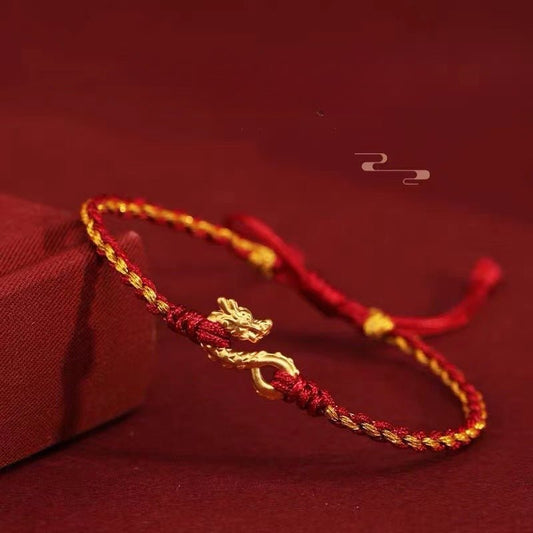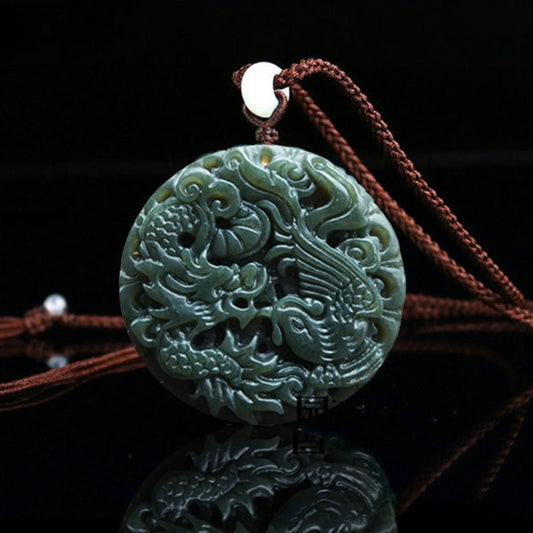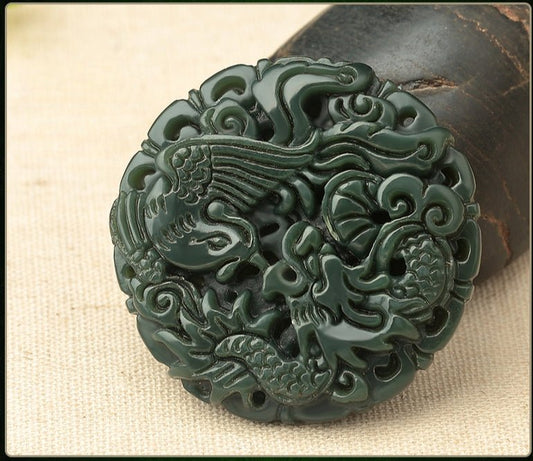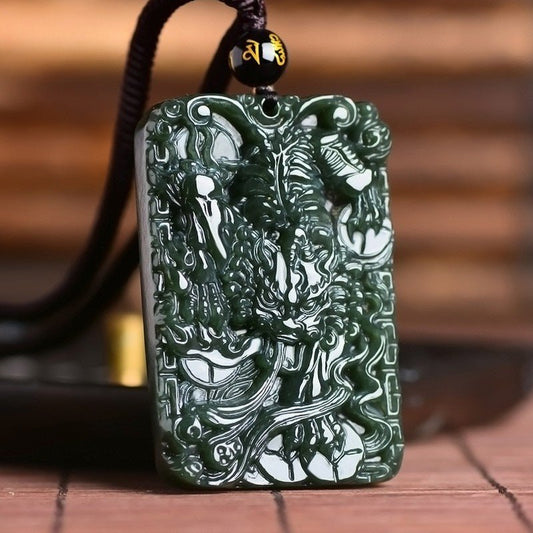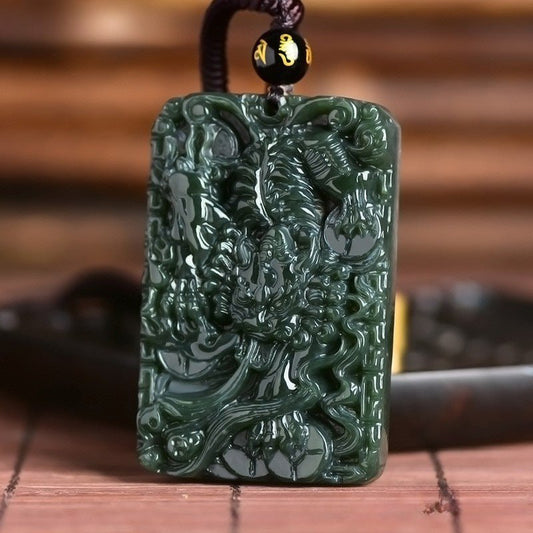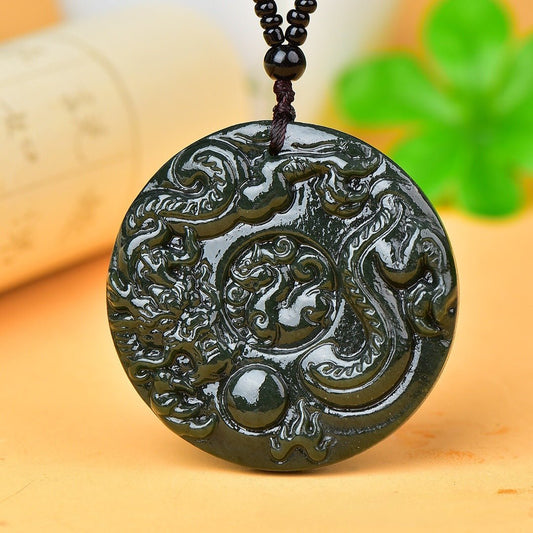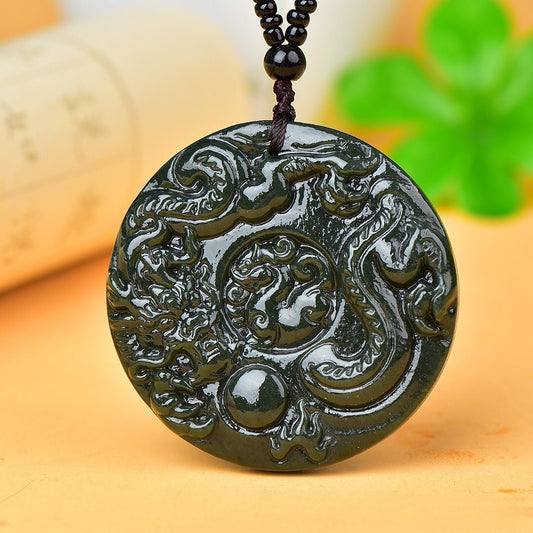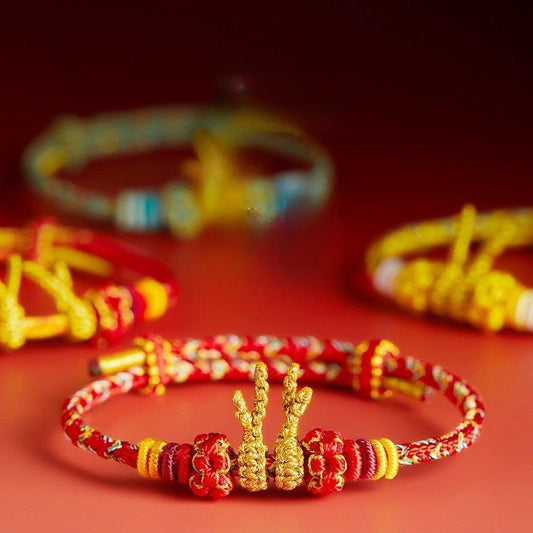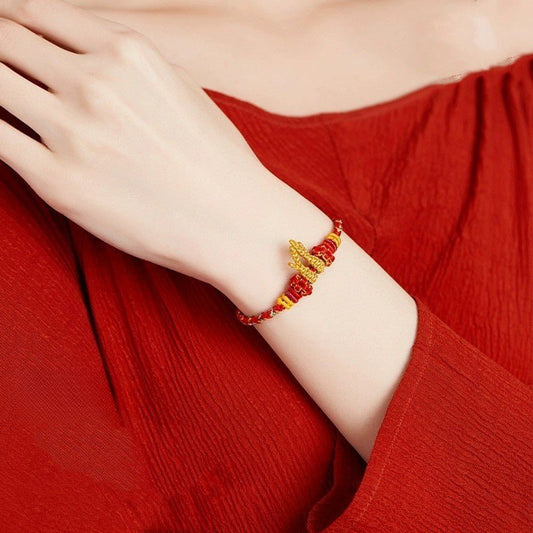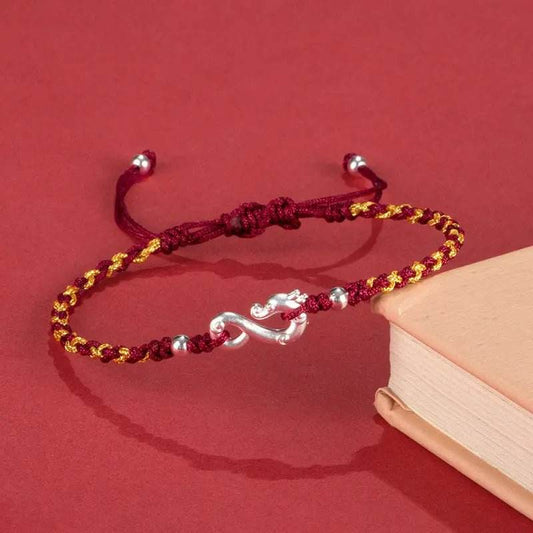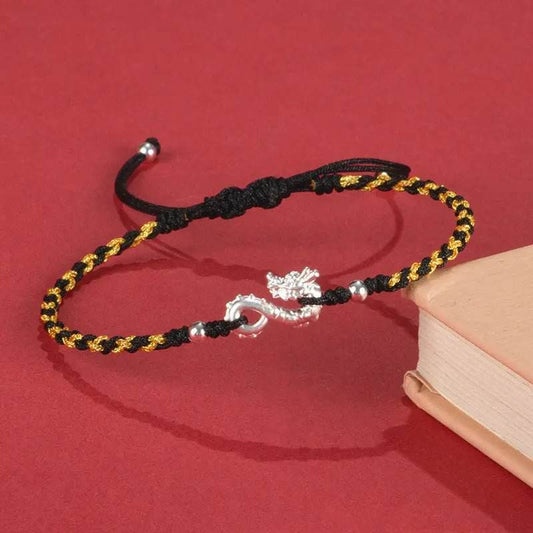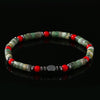-
Dragon Year Red String Bracelet - Handmade Adjustable Zodiac Bracelet with Dragon Charm for Good Luck - Couples Hand Rope
Regular price $15.88save: 53% Sale price $15.88 Regular priceUnit price / per$33.99Add a touch of elegance and good fortune to your life with this Dragon Year Red String Bracelet! 🌟 Handmade with love and care, this adjustable bracelet features a unique braided design and a dragon charm, symbolizing strength, courage, and prosperity in Chinese culture. Whether for yourself or as a meaningful gift for a loved one, this bracelet makes a perfect choice for those seeking good luck and positive energy. 🐉✨
Crafted with attention to detail, the Dragon Year Hand Rope is not only an accessory but a symbol of your personal journey and aspirations. The dragon represents the powerful spirit of the zodiac, offering blessings and protection for your new year.
This bracelet is fully adjustable, making it easy to wear for any wrist size. The rich red color combined with the golden dragon charm makes it a statement piece for any occasion, especially during the Chinese New Year or your Zodiac Year. 🎉
Product Features:
-
Handmade Craftsmanship: Each bracelet is carefully handwoven with intricate braiding, ensuring a one-of-a-kind design that represents both strength and beauty.
-
Symbol of Luck & Prosperity: The dragon charm is a symbol of good fortune and success, offering protection and blessings throughout the year. 🐉🍀
-
Adjustable Fit: Designed with a convenient adjustable slider, this bracelet fits most wrist sizes comfortably. 🌈
-
Perfect Gift: Ideal for couples, friends, or family members who appreciate meaningful, personalized jewelry.
-
Color Options: Available in vibrant red and elegant black color schemes to match your style or preference. ❤️🖤
-
Material: Premium quality cord and a durable, gold-tone dragon charm. 🌟
-
Occasions: Great for Chinese New Year, birthday celebrations, or as a year-round good luck charm.
Why You Should Buy:
-
Cultural Significance: This bracelet brings not only beauty to your style but also meaningful cultural symbolism, perfect for anyone who values traditional beliefs and good fortune. 🌸
-
A Thoughtful Gift: Show your love and care with a gift that conveys positivity and the promise of good fortune. A wonderful gift for couples, friends, or even family.
-
Versatile Wear: Whether you're dressing up or down, this bracelet effortlessly enhances your look, adding a special touch to your outfit. 👗👕
-
Great for the Year of the Dragon: Celebrate the Zodiac and bring the dragon’s energy of strength and spirit into your life. 🐉
Product Specifications:
-
Material: Handwoven cord (cotton/polyester blend), gold-tone metal dragon charm
-
Adjustable Size: One size fits most, adjustable from 14cm to 25cm
-
Color: Red, Black
-
Charm Dimensions: 2cm x 1cm
-
Package Includes: 1 x Red String Bracelet with Dragon Charm
FAQs:
-
Is the bracelet adjustable?
Yes, the bracelet features an adjustable cord, making it easy to fit different wrist sizes comfortably. ✨ -
What is the significance of the dragon?
In Chinese culture, the dragon represents strength, courage, and good fortune. It’s a symbol of protection and success. 🐉 -
Can I wear this bracelet every day?
Absolutely! It’s made with durable materials, and the adjustable feature ensures it stays secure and comfortable on your wrist. 🌟 -
Is this a good gift for couples?
Yes! This bracelet is a great gift for couples, as it symbolizes unity, prosperity, and protection in their relationship. 💑
Sale -
-
Handcrafted Hetian Jade Dragon & Phoenix Pendant Necklace - Couple’s Taiji Yin Yang Symbol
Regular price $28.88save: 54% Sale price $28.88 Regular priceUnit price / per$63.99Embrace the essence of tradition and elegance with this beautifully crafted Hetian Jade Dragon and Phoenix Pendant Necklace. This exquisite necklace features an intricately carved Dragon and Phoenix, symbolizing harmony, balance, and eternal love. The Taiji Yin-Yang design in the center reflects the perfect balance of opposing forces. Made from high-quality Hetian jade, it brings a sense of peace and positive energy to those who wear it. This pendant is ideal for couples, as it represents unity and balance. 🌟💚
Whether for daily wear or special occasions, the vibrant green hue and polished finish make this pendant a timeless addition to any jewelry collection. With each detail meticulously carved, it radiates sophistication and meaning.
Key Features:
-
Material: High-quality Hetian jade
-
Design: Carved Dragon and Phoenix with Taiji Yin Yang symbol in the center, representing balance and harmony
-
Style: Unisex design, perfect for both men and women
-
Size: Ideal size for wearing as a statement piece or as an everyday accessory
-
Necklace Type: Adjustable brown cord with bead accents
-
Symbolism: Dragon for strength, Phoenix for rebirth and new beginnings, and Taiji for balance and harmony
Why You Should Buy:
-
Premium Quality: Crafted from authentic Hetian jade, renowned for its fine texture and rich green color.
-
Symbolic and Meaningful Gift: This necklace is perfect for couples, representing eternal love, harmony, and balance.
-
Versatile: Suitable for both men and women, and can be worn with a variety of outfits.
-
Unique Design: The combination of the Dragon, Phoenix, and Taiji symbolizes strength, rebirth, and the balance of life.
Product Specifications:
-
Pendant Diameter: Approx. 45mm
-
Material: Authentic Hetian Jade
-
Cord Length: Adjustable to suit various neck sizes
-
Weight: Lightweight and comfortable to wear
Care Instructions:
-
To maintain the jade's shine and quality, avoid exposure to harsh chemicals and store in a safe place.
-
Gently clean with a soft cloth to keep the jade polished.
-
Avoid dropping the pendant to prevent damage.
FAQs:
-
Is this pendant suitable for daily wear?
Yes, the jade pendant is durable and designed for everyday use, adding elegance to any outfit. -
What is the meaning of the Dragon and Phoenix design?
The Dragon symbolizes strength and power, while the Phoenix represents rebirth and transformation. Together, they symbolize eternal love and unity. -
How do I care for the jade pendant?
To preserve the jade’s luster, avoid harsh chemicals and clean with a soft cloth. Store in a safe place away from extreme conditions.
Sale -
-
Hand-Carved Hetian Jade Dragon Pendant Necklace - Unique Natural Green Jade Charm with Pi Xiu Amulet for Luck & Protection
Regular price $28.88save: 54% Sale price $28.88 Regular priceUnit price / per$63.99This stunning Hetian Jade Dragon Pendant Necklace is meticulously hand-carved from the finest natural green jade. The pendant features a detailed dragon design, symbolizing power, strength, and good fortune, intertwined with the Pi Xiu amulet, which is widely recognized as a protector and a symbol of wealth and prosperity. Crafted with precision and care, this jade pendant offers a perfect balance between elegance and spiritual meaning, making it a remarkable addition to any collection.
The jade’s deep green hue and smooth finish reflect the craftsmanship of traditional jade artistry. Ideal for both men and women, this pendant is a beautiful token of protection, luck, and longevity. Whether worn for spiritual significance or as a fashionable accessory, it’s a meaningful piece that complements every occasion.
Features:
-
Material: Authentic Hetian Green Jade
-
Design: Carved Dragon & Pi Xiu Amulet
-
Symbolism: The Dragon represents power, strength, and success, while Pi Xiu is believed to bring wealth and protect against evil.
-
Craftsmanship: Hand-carved with meticulous attention to detail, showcasing the finest jade craftsmanship.
-
Unisex Design: Suitable for both men and women, making it a versatile gift or personal accessory.
-
Pendant Size: 50mm x 30mm (approximately)
-
Necklace Type: Adjustable string with high-quality beads
-
Color: Deep green jade with a polished finish
Why You Should Buy This:
-
Symbol of Wealth & Protection: Featuring the Pi Xiu amulet, believed to bring wealth and good fortune.
-
Handcrafted Excellence: Expertly carved by artisans, this jade pendant showcases traditional craftsmanship.
-
Timeless Design: A perfect combination of ancient tradition and modern elegance, suitable for any occasion.
-
Natural Green Jade: A prized gemstone known for its spiritual properties, including promoting calmness and health.
FAQs:
-
What is Hetian jade?
Hetian jade, a revered gemstone from China, is known for its smooth texture, rich color, and spiritual significance. -
What is the Pi Xiu amulet?
The Pi Xiu is a mythical Chinese creature that is believed to bring prosperity and protect its owner from evil. -
How should I care for my jade pendant?
Keep it away from chemicals or extreme heat. Clean with a soft cloth to maintain its shine. -
Is this pendant adjustable?
Yes, the necklace comes with an adjustable string, allowing for a perfect fit.
Sale -
-
Jade Necklace with Dragon Zodiac Pendant - Green Jade Amulet for Prosperity & Protection - Adjustable Necklace for Men & Women
Regular price $28.88save: 54% Sale price $28.88 Regular priceUnit price / per$63.99Add a powerful symbol of strength and good fortune to your collection with this stunning Jade Necklace with Dragon Zodiac Pendant. Crafted from authentic Hetian green jade, this necklace features a detailed Dragon Zodiac pendant—a timeless symbol of power, prosperity, and good luck in Chinese culture. The dragon represents courage, success, and vitality, making this pendant a perfect choice for those seeking to attract wealth and overcome obstacles.
Whether you're born in the Year of the Dragon or simply admire the majestic power of this mythical creature, this necklace serves not only as a spiritual amulet but also as a stylish accessory. The adjustable cord ensures a comfortable and personalized fit, making it suitable for both men and women.
Key Features:
-
Authentic Hetian Green Jade: Known for its deep cultural significance, jade is revered for its power to bring peace, prosperity, and balance.
-
Dragon Zodiac Pendant: The pendant features an intricate dragon carving, symbolizing strength, courage, and the ability to overcome adversity.
-
Healing and Prosperity: Green jade is believed to attract wealth and good fortune while promoting health and emotional healing.
-
Adjustable Cord: The durable cord is fully adjustable, offering a customized fit for different neck sizes.
-
Timeless Design: This necklace is a perfect blend of traditional Chinese symbolism and modern fashion, ideal for daily wear.
Why You Should Buy:
-
Symbol of Power and Fortune: The dragon, a symbol of luck and vitality, brings good fortune and protects its wearer.
-
Meaningful Gift: This necklace is an ideal gift for anyone born in the Year of the Dragon, or anyone who appreciates powerful symbolism and spiritual protection.
-
High-Quality Craftsmanship: The pendant is expertly carved from Hetian jade, ensuring durability and timeless beauty.
-
Versatile Design: Suitable for both men and women, this necklace complements any outfit while carrying deep cultural significance.
Product Specifications:
-
Material: Authentic Hetian Green Jade
-
Pendant Size: Approximately 60mm high, 40mm wide, and 10mm thick
-
Cord Type: Adjustable, durable fabric cord
-
Design: Intricate Dragon carving, symbolizing strength and prosperity
-
Weight: 50g
-
Color: Green jade with natural variations
FAQs:
Q: What does the Dragon symbolize in Chinese culture?
A: The Dragon is a symbol of strength, courage, and prosperity. It is believed to bring good fortune, success, and protection.Q: Is the cord adjustable?
A: Yes! The necklace features an adjustable cord to ensure a comfortable and personalized fit for any neck size.Q: How should I care for my jade pendant?
A: To preserve its beauty, gently clean your jade pendant with a soft cloth. Avoid exposure to harsh chemicals or extreme temperatures.Q: Can this pendant be worn daily?
A: Yes, the durable jade and adjustable cord make this pendant perfect for everyday wear, bringing both style and spiritual benefits.Sale -
-
Dragon Year Red String Bracelet - Dragon Charm Red Bracelet for Women – Perfect Lunar New Year Gift, Adjustable & Handmade
Regular price $19.88save: 54% Sale price $19.88 Regular priceUnit price / per$43.99This Dragon Year Red String Bracelet is more than just a piece of jewelry—it's a symbol of good fortune and protection. Perfect for those born in the Year of the Dragon, this bracelet features an intricately designed dragon charm, representing strength and power. Woven by hand with vibrant red and gold threads, it carries the energy of the Lunar New Year and is ideal for 2025, making it the perfect gift for women or couples.
Whether you are welcoming the Chinese New Year or simply want to bring good luck into your life, this bracelet is a stunning way to make a statement. Its adjustable design ensures a comfortable fit, and the bold dragon charm brings powerful symbolism to any outfit.
Why You Should Buy:
🌟 Good Luck & Protection: The dragon charm is a traditional symbol of strength, prosperity, and good fortune, making this bracelet a meaningful gift for any occasion, especially Lunar New Year. 🌟 Handmade Craftsmanship: Each bracelet is meticulously handwoven with red string, paired with golden dragon charms, ensuring high quality and durability. 🌟 Perfect for Gifting: Comes in a beautiful, gift-ready presentation, making it ideal for 2025 gifts, birthdays, or Year of the Dragon celebrations. 🌟 Adjustable & Comfortable: The bracelet is designed to fit a wide range of wrist sizes, offering comfort for all-day wear. 🌟 Traditional & Stylish: This accessory blends traditional symbolism with modern style, making it a versatile piece that complements both casual and festive outfits.
Product Specifications:
- Material: Red and Gold Thread, Dragon Charm
- Charm Dimensions: 3 cm x 2 cm
- Bracelet Length: Adjustable, fits most wrist sizes
- Packaging: Comes in a beautiful, red gift box
- Occasion: Perfect for Lunar New Year, Year of the Dragon, and other special celebrations
- Color: Red, Gold (charm)
Care Instructions:
- Avoid Moisture: Keep the bracelet dry to preserve its quality. Avoid contact with water, perfume, or cleaning chemicals.
- Store Carefully: When not wearing, store your bracelet in a dry and cool place to avoid damage.
- Clean Gently: Use a soft, dry cloth to wipe the charm and string if needed.
This Dragon Year Red String Bracelet is the perfect combination of tradition, style, and luck, designed to bring prosperity into your life. Celebrate the Year of the Dragon or gift this beautiful bracelet to someone special today! 🌟
Sale -
Jade Dragon Phoenix Pendants - 925 Silver Hetian Couples Necklace | STAR8S
Regular price $35.88save: 49% Sale price $35.88 Regular priceUnit price / per$70.99✨Romantic Jade Dragon Phoenix Pendants Selling Points
Elevate your love story with these jade dragon phoenix pendants. Crafted from 925 silver & Hetian jade, they feature dragon & phoenix designs. Ideal for couples, symbolizing good fortune & eternal love. Perfect for daily wear or gifting. 🎁
Unique vintage Chinese style! The dragon & phoenix represent power & beauty. Hetian jade adds elegance. Show your unique taste as a couple. 💑
Durable 925 silver ensures long - lasting wear. The meaningful design suits various occasions, from dates to festivals. Let it witness your love. 🌟
🎨Jade Dragon Phoenix Pendants Elements
Hetian Jade: The core of jade dragon phoenix pendants, smooth & natural. Represents purity & good wishes in Chinese culture. Symbolizes eternal love. 🍀
Dragon & Phoenix Design: The dragon stands for power & luck; the phoenix寓意beauty & grace. Together, they create an auspicious and romantic look. Perfect match! 🐉🦚
925 Silver: 925 silver chain is durable, skin - friendly. Complements jade well, ensuring comfortable & stylish wear for couples. ✨
⚙️Jade Dragon Phoenix Pendants Parameters
- Name: Dragon Phoenix Peace Buckle Couples Necklace
- Material: 925 silver, Hetian jade, synthetic cubic zirconia
- Weight: Men - 5g; Women - 3.96g
- Size: Men - 24mm (H) * 18mm (W); Women - 22mm (H) * 14.1mm (W)
- Color: Vintage gold
- Chain Length: Men - 50 + 5cm; Women - 40 + 5cm
⚠️Jade Dragon Phoenix Pendants Precautions
- Avoid contact with chemicals (perfume, lotion) to protect 925 silver & jade dragon phoenix pendants.
- Store in a dry box to prevent oxidation and scratches.
- Clean gently with a soft cloth; do not use abrasive materials.
- Manual measurement may have slight errors—refer to the actual product.
Sale -
STAR8S Year Of The Dragon Luck Protection Braided Bracelet: Chinese Traditional Auspicious Accessory
Regular price $15.88save: 55% Sale price $15.88 Regular priceUnit price / per$36.04Rich Cultural Implications: Belonging to the category of Chinese accessories, the bracelet features a core design of traditional Chinese dragon elements. In Chinese culture, the dragon is a symbol of power, nobility, auspiciousness, and luck. Wearing this bracelet implies being blessed by the dragon, bringing good luck and protection, especially suitable for commemorations or prayers related to the Year of the Dragon.
Exquisite Hand - woven Craftsmanship: Carefully hand - woven with high - quality strings, the knots are tight and the craftsmanship is delicate, showing the unique charm of traditional handicrafts. Each bracelet is unique and has high artistic value.
Beautiful Accessory Matching: The dragon - shaped accessory is vivid in shape and well - matched with the red and yellow interwoven strings. The color contrast is distinct and full of traditional festive atmosphere, not only highlighting the characteristics of Chinese traditional culture but also being fashionable.
Adjustable Size: The wrist circumference is 14 - 19cm, and the adjustable design can adapt to people with different wrist thicknesses, making it comfortable and convenient to wear and suitable for most people.
Usage Scenarios:
Year - of - the - Dragon Exclusive Wear: Wear it in the Year of the Dragon, which is in line with the zodiac year, adding a festive atmosphere and expecting good luck and protection in the Year of the Dragon. It is a characteristic accessory choice for the Year of the Dragon.
Traditional Festival Celebrations: Wear it during traditional festivals such as the Spring Festival and the Lantern Festival. The dragon elements and the red and yellow strings echo the festive atmosphere of the festivals, implying good luck, happiness, and well - being in the new year.
Important Occasion Memorials: Wear it on important occasions such as weddings, coming - of - age ceremonies, and business openings. The noble implications of the dragon add solemnity and blessings to the occasion, symbolizing beautiful expectations for the future.
Gift - giving: Give it as a gift to relatives and friends, especially those born in the Year of the Dragon or those interested in Chinese culture, to convey beautiful wishes of auspiciousness and luck, suitable for occasions such as birthdays and anniversaries.
Product Parameters:
Product Name: Year Of The Dragon Luck Protection Braided Bracelet
Band Type: Premium string
Wrist Circumference: 14 - 19cm
Material: String
Craftsmanship: Hand - weaving
Characteristic Decoration: dragon - shaped accessory
Precautions:
Avoid collision of the dragon - shaped accessory with sharp objects to prevent scratching or damage, affecting the appearance.
Try to avoid long - term contact of the bracelet with water or chemical substances, such as hand sanitizers and perfumes, to prevent the string from fading or the accessory from oxidizing.
When not in use, store it in a dry and cool place to avoid direct sunlight, which may cause the string to age.
Sale
Collection: Dragon
✨ What makes the Chinese dragon one of the most revered symbols in Asian culture? 🐉 The Chinese dragon is much more than a legendary creature; it represents strength, power, and prosperity. Unlike the fearsome Western dragons, the Chinese dragon is a benevolent force, associated with the natural elements and revered for its divine power and influence.
For centuries, the Chinese dragon has been an emblem of the imperial dynasty, fortune, and protection. It’s not only a symbol of supreme strength but also a bringer of good luck and abundance. In this article, we’ll explore why the Chinese dragon is so deeply intertwined with Chinese culture, its historical origins, its role as a symbol of power and strength, and how it continues to represent prosperity in various cultural practices today.
Let’s embark on a journey to understand this magnificent and auspicious creature. 🌿
1. The History and Origins of the Chinese Dragon 🏯
The Chinese dragon has a long-standing history, dating back to ancient Chinese civilization, where it was initially revered as a symbol of divine power and protection. Over time, the dragon evolved from a mythological figure into a symbol of imperial authority and good fortune.
Ancient Beginnings
The dragon’s history in China can be traced back to the Neolithic period, around 6,000 years ago. Early Chinese cultural artifacts from this era, such as pottery and jade carvings, depict the dragon in various forms. These early depictions show the dragon as an important ritual symbol, often representing the spiritual connection between the Earth and the heavens. 🌏✨
The dragon’s role in ancient Chinese mythology is deeply intertwined with the natural world. It was considered the controller of water, the master of the rivers, seas, and rain—elements essential for agriculture and survival. The dragon’s ability to summon rain was seen as a divine gift, and it was believed that the dragon could bring fertility to the land and ensure abundant harvests. 🌾💧
Dragon as a Mythical Creature
Unlike Western dragons, which are often depicted as fire-breathing beasts, the Chinese dragon is seen as a benevolent and auspicious figure. It is not associated with destruction but with life-giving power and protection. This mythical creature is typically shown with the body of a snake, the head of a camel, the horns of a deer, the eyes of a rabbit, the ears of a cow, and the claws of an eagle. Its long, serpentine body and majestic features symbolize the grace, strength, and divine nature of this revered creature.
The Dragon in Chinese Dynasties
During the reign of various Chinese dynasties, especially the Qin Dynasty and Ming Dynasty, the dragon became an emblem of imperial power. The emperor, as the "Son of Heaven," was believed to be the earthly incarnation of the dragon. In fact, the emperor’s throne was called the “Dragon Throne,” and the royal robes often featured dragon embroidery to signify their divine authority. 👑
The five-clawed dragon was particularly significant, as it was reserved exclusively for the emperor. The dragon’s five claws symbolized the emperor’s absolute power, rulership, and divine mandate. Emperors believed that as long as they wore the dragon’s image, they would be protected and their rule would be blessed by the gods. 🏯
2. The Dragon’s Symbolism of Power and Strength 💪
The Chinese dragon is primarily a symbol of power and strength. Its awe-inspiring appearance and its connection to the elements of nature make it a perfect representation of supreme authority. Let’s take a closer look at the symbolism of strength and power associated with the Chinese dragon.
Embodying the Essence of Power
The Chinese dragon is considered a symbol of supreme power. Unlike other creatures, it is believed to have the ability to control the natural elements, such as wind, rain, and storms. The dragon’s power is linked to its control over the world’s most powerful forces: water and air. These elements, critical to life on Earth, represent the dragon’s dominion over all creation.
Dragons were also seen as the embodiment of imperial power, with emperors considered the earthly embodiment of the dragon. The dragon’s fierce and majestic presence became synonymous with ruling authority and the divine right to govern. Whether on royal seals, flags, or furniture, the image of the dragon continued to represent power, strength, and absolute control over the land.
The Five-Clawed Dragon
One of the most powerful symbols of the dragon’s strength is the five-clawed dragon. This variant of the dragon, which possesses five claws on each paw, was a symbol that was exclusively used by the Emperor of China. It symbolized absolute authority, imperial divinity, and the emperor’s unrivaled dominion over the land.
The five claws of the dragon represented the five elements in Chinese philosophy: wood, fire, earth, metal, and water. These elements were believed to be the building blocks of the universe, and the emperor’s command over them was seen as the embodiment of total power. The five-clawed dragon became an important symbol of both material and spiritual power. 👑
The Dragon’s Physical Attributes
The physical attributes of the dragon—its long, sinuous body, sharp claws, majestic head, and glistening scales—are symbolic of its immense strength. The scales are said to represent protection and fortitude, as they are believed to be both impervious and flexible, making the dragon invincible to attack. Meanwhile, the claws are symbols of the dragon’s ability to fight and defend against enemies, further underscoring its role as a symbol of strength. 🐉💪
The dragon’s tail is also an important symbol. It represents the dragon’s ability to move gracefully, navigate challenges, and transform obstacles into opportunities. This balance of strength and grace makes the dragon an ideal symbol of power that is both unwavering and flexible.
3. The Dragon as a Symbol of Prosperity and Good Fortune 🌟
In addition to its associations with power and strength, the Chinese dragon is also a symbol of prosperity, good fortune, and abundance. Throughout Chinese history, dragons have been revered for their ability to bring blessings and success.
Bringer of Wealth and Abundance
The Chinese dragon is often linked to rain, which was critical to the agricultural success of ancient China. As the controller of water and rain, the dragon was believed to have the power to ensure bountiful harvests. The dragon’s ability to bring water to the land was seen as a source of fertility and growth, making it a symbol of prosperity and wealth. 🌾💧
In Feng Shui, the dragon is placed in certain areas of a home or office to attract wealth and abundance. It is often used in decorative items or art pieces to enhance prosperity and promote financial growth. For example, placing a jade dragon in the wealth corner of your home is thought to bring good fortune and prosperity into your life.
Dragon and the Emperor’s Prosperity
The dragon also symbolizes the prosperity of the emperor and the flourishing of the state. During imperial times, the emperor’s reign was often linked to the prosperity of the entire country. The dragon was believed to bring peace, stability, and economic success. Emperors were thought to be granted prosperity through their connection to the divine dragon, which symbolized the life force of the empire.
4. The Role of the Chinese Dragon in Festivals and Celebrations 🎉
The Chinese dragon is at the heart of many significant cultural celebrations, especially those linked to luck, prosperity, and good fortune. Let’s take a look at how the dragon plays an important role in festivals such as Chinese New Year and the Dragon Boat Festival.
Chinese New Year
The Chinese New Year is one of the most important festivals in Chinese culture, and the dragon plays a central role in the celebrations. The dragon dance, a traditional performance performed during the New Year, is believed to ward off evil spirits and bring good luck and prosperity for the year ahead. The dragon’s movements, which mimic the natural flow of energy, are thought to bring strength and good fortune to everyone who witnesses the dance. 🏮💃
5. The Chinese Dragon and Feng Shui 🏮
In Feng Shui, the ancient Chinese practice of harmonizing individuals with their environment, the dragon is considered one of the most potent symbols of good fortune, strength, and prosperity. It’s widely used in Feng Shui to activate positive energy and promote abundance in various areas of life.
Dragon as a Feng Shui Symbol
In Feng Shui, the dragon represents Yang energy, which is associated with action, activity, and masculine power. It is a dynamic symbol that can bring vitality and positivity into any space. The Chinese dragon is often placed strategically in homes, offices, or businesses to activate the wealth sector, health sector, or other key areas based on your needs.
The dragon’s energy is particularly powerful when placed in the South sector of your home or business, as it symbolizes fame, recognition, and achievement. It is believed that placing a dragon figurine in this area can enhance success, visibility, and personal empowerment. 🌟
Water Dragon for Wealth and Prosperity
In Feng Shui, the water dragon is especially significant when it comes to financial abundance. The dragon’s affinity with water symbolizes fluidity and flow, allowing wealth and prosperity to move easily into your life. A jade dragon figurine near a water feature, such as a fountain or aquarium, is thought to magnify its prosperity-enhancing effects. 🌊💰
The Dragon and the Phoenix in Feng Shui
The pairing of the dragon and the phoenix in Feng Shui is a powerful representation of balance. The dragon symbolizes masculine energy, while the phoenix represents feminine energy, creating a dynamic union that enhances harmony and growth. Together, they are believed to bring prosperity, balance, and good fortune to any space. 🌿🦋
6. The Chinese Dragon in Art and Architecture 🖼️
The Chinese dragon is a common feature in Chinese art and architecture, where it is used to convey strength, power, and imperial authority. The presence of the dragon in these artistic forms underscores its revered status as a symbol of divine protection and good fortune.
Dragon in Traditional Art
Throughout Chinese history, dragons have been depicted in paintings, sculptures, and embroideries. Traditional Chinese art often portrays the dragon in a majestic, flowing form, showcasing its grace, strength, and power. These artistic representations are often seen on scrolls, ceramic vases, silk tapestries, and even jade carvings, each serving as a reminder of the dragon’s divine and powerful nature. 🎨🐉
The dragon’s image is also central to Chinese calligraphy and symbolism, often appearing as part of ancient royal seals, official decrees, and ceremonial objects. In this context, the dragon represents the legitimacy and authority of the emperor or the ruling class. 🖌️
Dragons in Architecture
The Chinese dragon also plays a significant role in Chinese architecture, particularly in imperial palaces, temples, and gateways. Imperial palaces like the Forbidden City are adorned with dragon motifs carved into columns, roofs, and doors to signify the emperor’s divine authority. The dragon’s presence in architecture serves as a mark of power and protection over the space.
Dragons are often depicted on the roofs of palaces, in architectural carvings, or as part of the decorative design in royal court halls. These representations highlight the emperor’s connection to divine power and the imperial protection granted by the dragon. 🏯
Dragon as a Symbol of Good Luck in Art
Beyond royalty, dragons are also used in everyday art and decorations to symbolize luck, prosperity, and happiness. Whether in porcelain figurines, wall hangings, or home décor, the dragon continues to represent positive energy and good fortune in modern Chinese homes and businesses. 🏡
7. The Chinese Dragon in Modern-Day Culture 🌍
The Chinese dragon continues to be a symbol of strength and prosperity, not only in traditional Chinese culture but also in modern-day life. Its impact can be seen globally, from festivals to fashion to its presence in pop culture.
The Dragon in Chinese New Year
One of the most prominent celebrations where the Chinese dragon plays a key role is the Chinese New Year festival. During this celebration, the dragon dance is performed to usher in prosperity and good fortune for the coming year. 🏮✨
The dragon dance is often performed by a group of people who move a long dragon costume in a series of fluid, graceful motions, symbolizing the dragon’s strength, vitality, and ability to drive away evil spirits. The dragon is believed to bring good luck and success for the year ahead, especially in terms of wealth and health. 🌟🎉
The Chinese Dragon in Fashion
In modern times, the Chinese dragon has been embraced in fashion and design. The dragon appears in clothing, accessories, and even tattoos, symbolizing power, good fortune, and prosperity. Dragon motifs are often featured on silk robes, scarves, and jewelry, especially among those who seek to harness its energy for success and harmony. 🧵👗
The Chinese Dragon in Pop Culture
The Chinese dragon has also made its way into pop culture across the globe. From movies like Mulan and Kung Fu Panda to comics, graphic novels, and video games, the dragon remains a symbol of bravery, strength, and mystical powers. In many Western depictions, the Chinese dragon is portrayed as a wise and powerful entity, contrasting with the more destructive and fire-breathing Western dragons.
In tattoos, the Chinese dragon is frequently chosen for its symbolic representation of strength, endurance, and the ability to overcome adversity. 🐉💪
8. The Enduring Power of the Chinese Dragon 🌟
The Chinese dragon remains a timeless symbol of power, strength, and prosperity in both traditional and modern contexts. Whether in the imperial courts, cultural festivals, Feng Shui, or art, the dragon continues to symbolize positive energy, good fortune, and divine protection.
From ancient times to the present, the Chinese dragon has remained an enduring emblem of empire, health, and good fortune, influencing art, culture, and spiritual practices. Its symbolic significance continues to inspire generations, offering a powerful connection to both the past and the present.
Recap of Key Points
-
The Chinese dragon is a symbol of power and strength, revered for its ability to control natural elements like water and rain.
-
It is a symbol of prosperity, associated with fertility, wealth, and abundance.
-
The dragon’s role in Feng Shui, art, and festivals continues to shape cultural and spiritual practices.
-
In modern times, the Chinese dragon is still a popular symbol in fashion, tattoos, and pop culture.
FAQs Section:
Q1: Why is the Chinese dragon different from Western dragons?
A1: The Chinese dragon is fundamentally different from Western dragons in terms of its symbolism, appearance, and cultural significance. While Western dragons are often depicted as ferocious, fire-breathing creatures that are associated with destruction and evil, the Chinese dragon is a benevolent, peaceful creature that symbolizes strength, prosperity, and protection. The Chinese dragon is often shown as long, serpentine, with antler-like horns, claws, and scales, signifying a balance of power and grace. In Chinese culture, the dragon is a symbol of good fortune, divine rule, and prosperity, often associated with imperial authority and natural forces, such as rain and water. 🌊🐉
Q2: What does the Chinese dragon symbolize during Chinese New Year?
A2: During Chinese New Year, the dragon symbolizes good fortune, prosperity, and strength. The dragon dance, performed during New Year celebrations, is meant to ward off evil spirits and attract positive energy. It is believed that the movement of the dragon brings abundance, joy, and success for the year ahead. The presence of the dragon during the New Year festivities also marks the beginning of a new cycle of growth and opportunity, ensuring luck and prosperity for everyone who participates. The dragon is seen as the guardian of good fortune, protecting families and individuals from bad luck and negative influences. 🎉🐉
Q3: Can the Chinese dragon bring good luck and prosperity?
A3: Yes, the Chinese dragon is widely regarded as a symbol of good luck and prosperity. It is believed to possess divine power that can influence various aspects of life, such as wealth, health, and harmony. In Feng Shui, the dragon is often placed in specific locations within homes or businesses to attract wealth and abundance. The water dragon, in particular, is known for its association with financial success, as it represents the flow of money and opportunity. The Chinese dragon’s ability to control natural elements like water and rain symbolizes the power to provide and ensure growth in all areas of life. 💰🌟
Q4: How can I incorporate the Chinese dragon into my home for good fortune?
A4: Incorporating the Chinese dragon into your home for good fortune can be done in a few different ways, depending on your preferences and the specific areas of life you want to enhance:
-
Dragon Figurines: Place a dragon figurine in the wealth corner (southeast) of your home to attract financial prosperity and abundance. A jade dragon can be especially beneficial as jade is associated with prosperity and healing.
-
Dragon in Feng Shui: In Feng Shui, the dragon can be placed near water features, such as a fountain or aquarium, to enhance prosperity and luck. The combination of the dragon’s symbolic power with the energy of water promotes the flow of wealth and success.
-
Dragon Artwork: Hang a painting or print of a dragon in your living room or office to bring strength, harmony, and positive energy. Ensure that the dragon is depicted in a dynamic and positive light, which reflects its auspicious nature.
By strategically placing the dragon in these areas, you invite its energy into your home, creating a space filled with prosperity, good health, and protection. 🏮✨
Q5: Why is the Chinese dragon important in Feng Shui?
A5: The Chinese dragon plays a crucial role in Feng Shui due to its symbolism of strength, prosperity, and divine protection. In Feng Shui, the dragon is a Yang symbol, representing active, masculine energy that brings vitality, growth, and wealth. Dragons are often used to activate specific areas of the home or workplace, such as the wealth sector (southeast) and the fame sector (south), helping to enhance financial success and recognition.
The dragon’s connection with water (especially the water dragon) is linked to the flow of abundance and money, which makes it a powerful tool for attracting wealth. Additionally, the dragon and phoenix combination in Feng Shui is considered a powerful symbol of balance and harmony, as the dragon represents masculine energy and the phoenix represents feminine energy. Together, they create a balanced environment that promotes good fortune and growth in both personal and professional aspects. 🌿🐉










